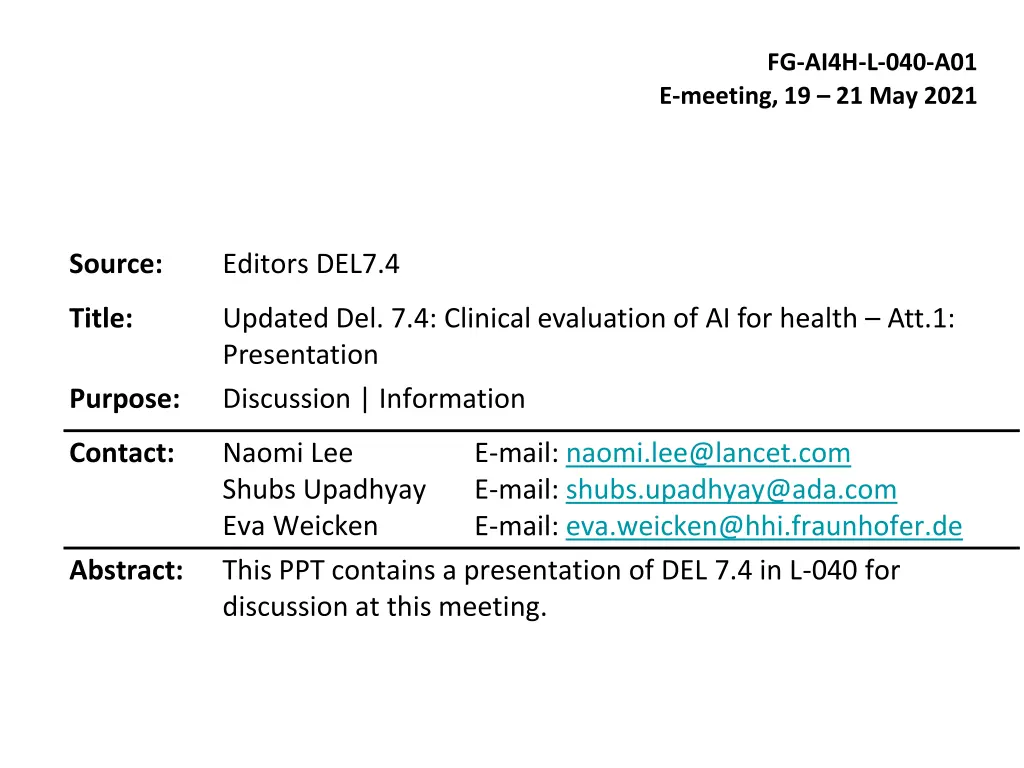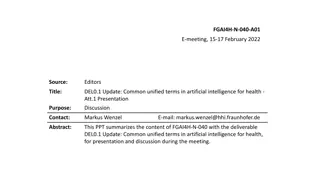
Clinical Evaluation of AI for Health: WG-CE Overview
Explore the working group on Clinical Evaluation within FG-AI4H and their objective to build a collaborative community around AI evaluation. Learn about the organization, members, and guiding principles for widespread applicability in healthcare settings globally.
Download Presentation

Please find below an Image/Link to download the presentation.
The content on the website is provided AS IS for your information and personal use only. It may not be sold, licensed, or shared on other websites without obtaining consent from the author. If you encounter any issues during the download, it is possible that the publisher has removed the file from their server.
You are allowed to download the files provided on this website for personal or commercial use, subject to the condition that they are used lawfully. All files are the property of their respective owners.
The content on the website is provided AS IS for your information and personal use only. It may not be sold, licensed, or shared on other websites without obtaining consent from the author.
E N D
Presentation Transcript
FG-AI4H-L-040-A01 E-meeting, 19 21 May 2021 Source: Editors DEL7.4 Title: Updated Del. 7.4: Clinical evaluation of AI for health Att.1: Presentation Discussion | Information Purpose: Contact: Naomi Lee Shubs Upadhyay Eva Weicken This PPT contains a presentation of DEL 7.4 in L-040 for discussion at this meeting. E-mail: naomi.lee@lancet.com E-mail: shubs.upadhyay@ada.com E-mail: eva.weicken@hhi.fraunhofer.de Abstract:
WG-CE: Working Group on Clinical Evaluation FG-AI4H meeting L , 19 - 21 May 2021
Agenda Agenda - - Status update WG Status update WG- -CE CE Introduction WG-CE A Timeline - where we are to date B Introduction draft outline Table of content C Presentation draft outline (high-level overview of sections) D Next steps E
Introduction WG-CE A Working Group on Clinical Evaluation within FG-AI4H
Introduction WG WG- -CE CE A Part of No. 7 deliverable AI4H evaluation considerations (umbrella) Output document of the Working group on Clinical Evaluation Update DEL 7.4 to meeting L: Draft outline version 1.1 (before sharing with WG-CE, feedback not included yet)
Introduction WG-CE A Objective Build a community of collaboration around clinical evaluation of AI for health Guidance for current best practice evaluation, principles of evaluation to ensure it is generally relevant across all countries Used by researchers, clinicians, patients, developers, civil-society, policy-makers special consideration of clinical evaluation in LMIC settings applicable for FG-AI4H
Introduction WG-CE A Organization of collaboration 65+ members from all around the globe (academia, research, clinicians, commissioning, etc.) Co-chairs: Naomi Lee, Shubs Upadhyay, Eva Weicken Writing comittee: above mentioned & Kassandra Karpathatkis, Alastair Denniston, Jane Carolan, Tommy Wilkinson, Xiao Liu Outline (Del7.4) based on contributions of ALL members
Timeline - Where are we to date? B Outline
Introduction draft outline C Table of contents Introduction & Background Scoping phase Design phase Development phase Building data Testing and validation Clinical studies, safety and efficacy Economic evaluation Implementation of algorithm Ongoing monitoring Recommendations
Presentation outline draft D Introduction & Background Objective: guidance for best practice evaluation, emphasis on principles of evaluation (relevance across all countries, ensure AI is safe, effective, cost-effective) Following AI life cycle and draw on existing evaluation frameworks Audience Information about the contributors/FG-AI4H Global scope, interest in evaluation that supports SDG-3 Considerations on evaluation in LMIC settings Collaboration within FG-AI4H (WGs, TGs)
Presentation outline draft D Scoping Phase & Design phase Helping procurers, competent authorities, decision makers consider a structured approach. Has the developer demonstrated these things: That the problem space is really understood That AI is indeed the right tool to solve the problem Defined intended users and intended benefits Worked with clinical and other stakeholders to scope and define potential risks Worked to understand the clinical context, setting, and impacts Understanding its usability and fit in existing workflows (core questions), user centered approach Started to design and plan for evaluation of benefits at patient, clinical and system level
Presentation outline draft Presentation outline draft D Development phase I Building Transparency of training data required in order to evaluate: quality of labels (expert opinion, biopsy confirmed), inclusiveness of data (gender/sex, age, race/ethnicity) Is it representative of the situation in which it will be used? Testing and validation Analytical validation: External validation - testing model in an unseen, external dataset representative of setting and population of intended use. Identify failure cases. Comparative benchmarking of AI tools), might be a way to constantly and quickly evaluate dynamic AI tools Data availability may be a challenge Reader Study Provide the tool to the intended user and evaluate its performance in the workflow
Presentation outline draft Presentation outline draft D Development phase II Clinical studies, safety and efficacy aim to minimizing bias and give confidence (evidence AI is effective and safe when deployed), prospective analysis plan, reporting in line with this and reporting guidelines designed to evaluate impact on whole pathway and with clinically meaningful endpoint RCTs are the benchmark of clinical studies, but other forms of study can be undertaken when this is not feasible - but this does require additional consideration of potential bias Consider: Study design (effectiveness, safety, cost effectiveness) Population (diverse and reflects that of intended use setting) Intervention (described in a way that it can be replicated) Comparator (relevant reference that is SOC) Pre specified outcomes, process measures Registered and reported Prospective observational studies with a relevant comparator, meaningful outcome and systematic safety reporting can be considered adequate for some tools
Presentation outline draft Presentation outline draft D Economic evaluation Evaluation requires measurement of costs (direct and associated implementation costs), and wider economic considerations relative to estimated clinical effect Comparative analysis of two or more interventions in terms of their costs and consequences which informs funding decisions AI supported digital health interventions require more consideration for their economic evaluation than simple, individually consumed non-digital health technologies World Bank is engaging in collaborative effort to develop framework for economic evaluation of digital health interventions due for publication 2021 Innovation or development costs can be substantial, but then marginal cost can approach zero, costs dependent on local digital architecture Economic evaluation can be informed by real world data The basic premise of costing for economic evaluation is that costs should reflect full net costs of the intervention aligning to the specification of the intended decision maker. This requires therefore that when estimating costs, the decision problem, perspective of the decision maker, an understanding of what the intervention would displace in the context of the decision problem should be established. consider build cost, maintenance, delivery, site costs Reimbursement
Presentation outline draft Presentation outline draft D Implementation of algorithm Demand from health systems to accelerate technological solutions to address crisis AI may be deployed earlier in evaluation process demand, some factors show during deployment at large scale), esp. generalisability > therefore need to continued evaluation Risk of harm can be considered in terms of likelihood and consequences -- rapid scaling following single centre evaluation in homogenous popn has higher chance of failure, can mitigate Determine level of additional evaluation (version updates, continuously learning systems) Ongoing monitoring Not solely responsibility of developers but including wide groups (patients, public, HCP, etc.) Of performance (safety and effectiveness), e.g. unexpected outputs, variations in clinical workflow AEs may be a considerable way downstream Requirements for post market surveillance plan, reported adverse events Algorithmic audits for analysis of adverse events
Presentation outline draft D Recommendations Procurers of AI tools should be clearer about the economic evaluation for AI tools Priority setting for digital tools in all country settings requires a much more active role for health technology assessment, in addition to the role of regulators Benchmarking of AI tools either by local procurers or by national agencies - e.g., FG-AI4H open code initiative Longer term analysis of AI tools is required (Collaborative studies would accelerate progress and should be considered a priority) Needs-based development of tools requires a dedicated effort to collect data in underrepresented populations and where AI may be effective, but datasets are poor All stakeholders must be encouraged to make clinical studies to be more open and accessible
Next steps Next steps E sharing with WG members for second round of feedback Available to view in the Deliverable documentation 7.4: welcome comments follow-up meetings purpose for FG-AI4H : in particular - application/translation to topic groups? synchronization with other FG-AI4H WGs e.g., language, life-cycle approach, overall implementation wider external awareness and publication
Thank you & Join us! Thank you & Join us! Co-chairs: Naomi Lee, The Lancet Shubhanan Upadhyay, Ada Health Eva Weicken, Fraunhofer HHI Please contact: eva.weicken@hhi.fraunhofer.de




